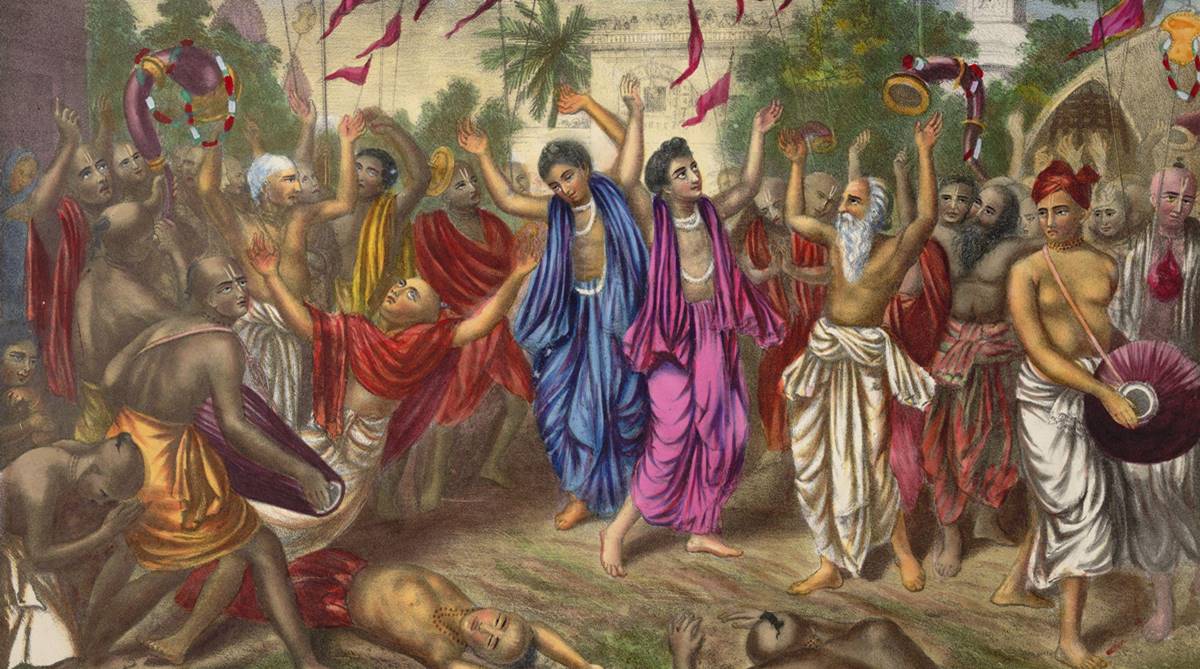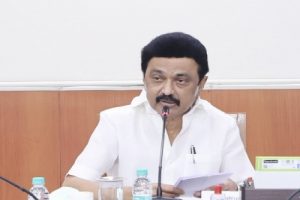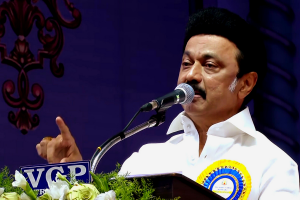In an essay, Christian Novetzke asserts that “all manifestations of bhakti are performances and, more to the point, public ones, that is performances that are part of, or help form publics of reception.’ In Bengali Vaishnavism, the “manifestation” of devotion is channelized through the performance of kirtan in the true sense. The history of kirtan dates back to Jayadeva’s Gitagovinda, a Sanskrit lyric idealising the love of Radha and Krishna. Vidyapati, a Maithili poet, was the next exemplary figure in the history of kirtan, followed by Badu Chandidas.
By the time Sri Chaitanya arrived, kirtan had already made a mark as a well-developed genre of devotional performance in Bengal, with established rules of form and music. Sub-genres of kirtan, such as padakirtan and palakirtan, had already been popular due to the emergence of mature musical tradition where one of the singers would take the lead and musicians would accompany him with various instruments so as to produce the musical setting of a refrain.
Advertisement
An acclaimed practitioner and performer of kirtan, Palash Sarkar of Nadia, while performing at a Kirtan festival organised by Aloke Sangha, Sukanta Nagar, Siliguri, explained, “Kirtan evolved into a rich and highly regulated phenomenon in the style of Dhrupad. Both raga (musical modes) and tala (rhythmical structures) were carefully regulated so as to produce the right efflorescence of devotional effect through hearing kirtan.” In Bengal, this form of kirtan further developed into padabali-kirtan or lilakirtan.
Speaking to the author, Mr Sarkar elaborated this in a lucid way: “Lilakirtan consists of songs of separation (vipralamba) and songs of union (sambhoga). They follow established norms of describing 32 rasas of separation and 32 rasas of union of the hero and the heroine (nayak-nayika). These rasas trace the flow of their passions gradually, from the first exchange of glances to the final ecstatic union, with the stages of smittenness, jealousy, initial meetings, secret rendezvous, and long and short unions in between.”
In course of time, Sri Chaitanya himself became the subject matter of a number of kirtans. These lyrics were called gaurachandrika, and they covered various phases of Sri Chaitanya’s life. A standard practice followed by kirtan performers in Bengal was to begin a performance with gaurachandrika, followed by songs about Radha and Krishna. Sri Chaitanya himself is known to have changed kirtan in two fundamental ways: he democratized the practice of kirtan by making it open to all, and he introduced new forms of kirtan called nagarkirtan and naam-kirtan.
Commenting on the contribution of Sri Chaitanya in ushering in “cultural renaissance,” Kirtan Shastri Sri Palash Sarkar pointed out, “It was the darkest period of Bengal. Society was writhing under the curse of caste rigidities and tyranny of the rulers. After Gautama Buddha, it was Mahaprabhu who spearheaded the notion of peace in an effort to lead humanity to and along the path of enlightenment. Sri Chaitanya turned out to be a rebel by defying the order of the Kazi to stop Hari Sankirtan. His undaunted spirit inspired millions of Bengalis of the time, irrespective of religious differences, to rise against injustice and torture. It was Sri Chaitanya in Bengal who for the first time broke down the barrier of caste and creed and embraced the Chandalas even as his brothers. Through his preaching he had created an aura of spiritual consciousness. The Bhakti Movement that followed culminated in “cultural renaissance” of India. Sri Chaitanya made it possible for us to shift our vision back to God once more.”
Norman Cutler, in his study of devotional singing, has observed that no performance of kirtan is a strictly private affair, and all the performances of this kind of devotional practice bring in a tripartite network consisting of the performer, the God, and the audience.
The sudden eruption of kirtan in the streets of Nabadwip was something startlingly novel introduced by Sri Chaitanya. The latter turned kirtan from being a form of devotional singing before an audience to a vibrant public procession. The participants would get transported to an extreme state of laughter, or tears, or rolling on the ground, or ecstatic dancing – all characteristics of a deeply affected state of Bhakti. The Bengali devotional corpus is hugely indebted to Sri Chaitanya-but the songs are about him, not by him. Unlike Kabir and others of his ilk, Chaitanya does not command us to listen to him, but invites us to enact, embody, and experience divine grace.
It is needless to say that Sri Chaitanya’s intense spiritualism infected many and started a movement across many regions of India.
Chaitanya emphasized the role of merely uttering God’s name in obtaining emancipation, and kirtan as introduced by Mahaprabhu has been central to the path of enlightenment as is envisaged by his disciples.
While asked about the relevance of kirtan in contemporary hard times, Mr Sarkar started cataloguing how kirtan is beneficial to brave the battles of existence amidst confusion and haphazards of life by simplifying one ‘sloka’ of Mahaprabhu: “Kirtan purges mind of its impurities and feeds it with nobler thoughts and clarity of vision; kirtan brings in harmony by incorporating all, irrespective of division and quarrel in caste, creed and race; kirtan broadens human mind so as to get connected with mass selflessly; it is instrumental in gaining spiritual knowledge; kirtan transports one in a trance-like state which is a source of spiritual ecstasy; it enables human mind to have a taste of divine bliss as if it were an elixir of a kind; kirtan bridges the gulf between the human and the divine, thereby preparing Jive-Atman to meet with Paramatman.”
As to the question of “Who is Chaitanya?” Kedarnath Datta Bhaktivinoda, who pioneered the spread of Chaitanya’s teachings in the West, once summed up the issue beautifully: “We leave it to ours readers to decide how to deal with Mahaprabhu. The Vaishnavas have accepted him as the great Lord Krishna himself. Others have regarded Him as bhakti-avatar…Those who are not prepared to go with them, may accept Nimai Pandit as noble and holy teacher. That is all we want our readers to believe.”
(The author is Associate Professor of English, Munshi Premchand Mahavidyalaya, Siliguri)











